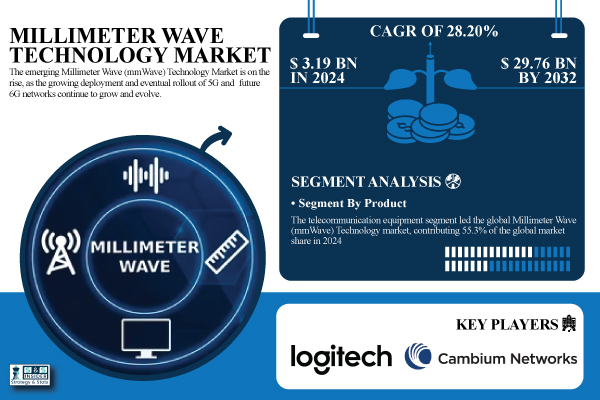
News
November 03, 2025
Millimeter Wave Technology Market Size to Hit USD 29.76 Billion by 2032 | at a CAGR of 28.20% | SNS Insider
Millimeter Wave Technology Market growth is driven by 5G rollout, demand for high-speed data transfer, automotive radar use, advanced imaging, and adoption in defense & satellite communications. Millimeter Wave Technology Market growth is driven by 5G rollout, demand for high-speed data transfer, automotive radar use, advanced imaging, and adoption in defense & satellite communications.
The global Millimeter Wave Technology market is poised for explosive growth, projected to reach a staggering USD 29.76 billion by 2032, according to a new report by SNS Insider. This represents a compound annual growth rate (CAGR) of 28.20% over the forecast period, signaling a significant surge in the adoption and implementation of this advanced technology.
What's fueling this impressive expansion? Several key factors are converging to create a perfect storm for the Millimeter Wave Technology market. Primarily, the ongoing rollout of 5G networks is a major driver. Millimeter wave frequencies are crucial for delivering the ultra-fast speeds and low latency promised by 5G, enabling applications like augmented reality, virtual reality, and enhanced mobile broadband.
Beyond 5G, the escalating demand for high-speed data transfer across various industries is also contributing significantly. Businesses and consumers alike are increasingly reliant on bandwidth-intensive applications, driving the need for faster and more reliable communication solutions. Millimeter wave technology offers a compelling solution by providing the necessary bandwidth to handle these growing data demands.
The automotive industry is another key adopter, leveraging millimeter wave technology for advanced driver-assistance systems (ADAS) and autonomous driving. Automotive radar systems utilize millimeter wave frequencies to detect objects and obstacles, enabling features like adaptive cruise control, blind-spot monitoring, and automatic emergency braking, enhancing safety and paving the way for self-driving vehicles.
Furthermore, the demand for advanced imaging technologies in healthcare, security, and industrial applications is boosting the market. Millimeter wave imaging offers high-resolution and non-destructive inspection capabilities, making it valuable in medical diagnostics, security screening, and quality control processes.
Finally, the defense and satellite communications sectors are increasingly adopting millimeter wave technology for secure and reliable communication links. Its high bandwidth and resistance to interference make it ideal for military communications, satellite-based internet services, and other critical applications. The combined influence of these factors underscores the significant potential of millimeter wave technology across diverse sectors, positioning it for continued and substantial growth in the years to come.
What's fueling this impressive expansion? Several key factors are converging to create a perfect storm for the Millimeter Wave Technology market. Primarily, the ongoing rollout of 5G networks is a major driver. Millimeter wave frequencies are crucial for delivering the ultra-fast speeds and low latency promised by 5G, enabling applications like augmented reality, virtual reality, and enhanced mobile broadband.
Beyond 5G, the escalating demand for high-speed data transfer across various industries is also contributing significantly. Businesses and consumers alike are increasingly reliant on bandwidth-intensive applications, driving the need for faster and more reliable communication solutions. Millimeter wave technology offers a compelling solution by providing the necessary bandwidth to handle these growing data demands.
The automotive industry is another key adopter, leveraging millimeter wave technology for advanced driver-assistance systems (ADAS) and autonomous driving. Automotive radar systems utilize millimeter wave frequencies to detect objects and obstacles, enabling features like adaptive cruise control, blind-spot monitoring, and automatic emergency braking, enhancing safety and paving the way for self-driving vehicles.
Furthermore, the demand for advanced imaging technologies in healthcare, security, and industrial applications is boosting the market. Millimeter wave imaging offers high-resolution and non-destructive inspection capabilities, making it valuable in medical diagnostics, security screening, and quality control processes.
Finally, the defense and satellite communications sectors are increasingly adopting millimeter wave technology for secure and reliable communication links. Its high bandwidth and resistance to interference make it ideal for military communications, satellite-based internet services, and other critical applications. The combined influence of these factors underscores the significant potential of millimeter wave technology across diverse sectors, positioning it for continued and substantial growth in the years to come.
Category:
Technology